The Australian Dollar is on "Shaky Ground", Time to Sell, says Westpac
- Written by: James Skinner
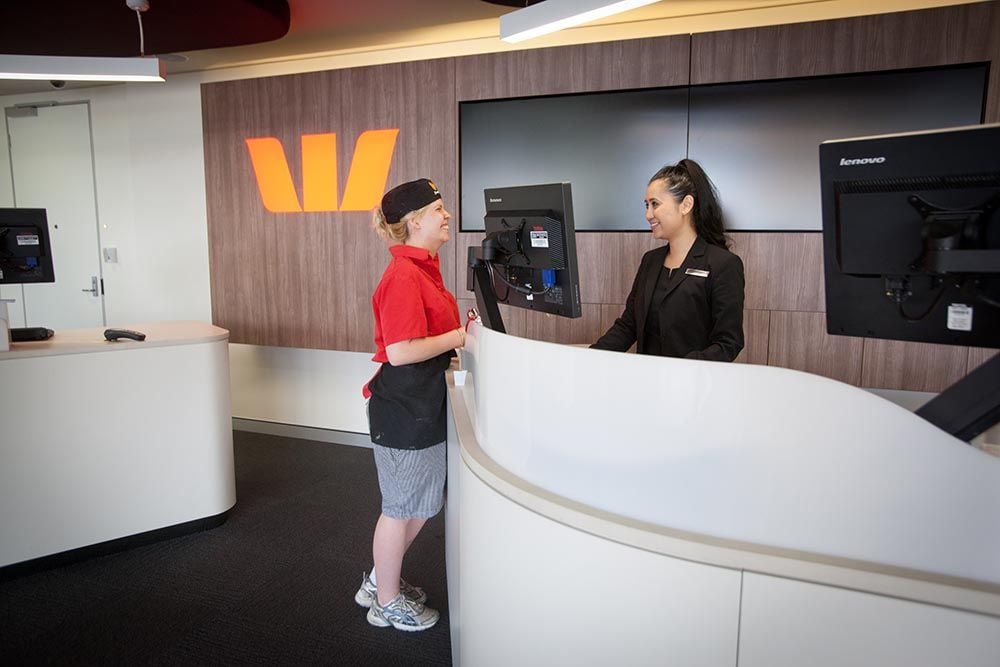
© Westpac
- AUD advances as USD cedes ground but Westpac looks for losses.
- AUD on "shaky ground" as economy weakens, augurs more RBA cuts.
- Looming AUD weakness to fuel a 5% Pound-to-Aussie rate rise in 2019.
The Australian Dollar is on shaky ground according to analysts at Westpac, who say it's vulnerable to declines even as the Antipodean unit attempts to breaking above a key resistance level currently held by its U.S. counterpart.
Westpac, one of Australia's four largest lenders, has told institutional clients they should sell the Aussie currency against the U.S. Dollar because analysts at the bank expect it to fall to fresh lows before the year is out.
This dire outlook for the Antipodean currency is partly why Westpac also forecasts a more-than 5% increase in the Pound-to-Australian-Dollar rate before the curtain finally closes on 2019. The bank doesn't predict any gains for the Pound against the U.S. Dollar from Thursday's levels.
"The US dollar has been hit by aggressive pricing for Fed rate cuts, partly inspired by the US tariff threat to Mexico. This has helped AUD hold up against USD but it is on shaky ground multi-month given Australia's poor Q1 GDP report reinforces our view that the RBA cash rate will need to fall below 1%," says Sean Callow, a strategist at Westpac.
Australian GDP growth came in at 0.4% for the first-quarter Wednesday, up from the 0.2% but below the consensus for 0.5%. This left the annualised pace of expansion running at just 1.8% - below what the Reserve Bank of Australia (RBA) calls 'trend' growth and insufficient for the economy to generate the inflation required for more interest rate cuts to be avoided in the near future.
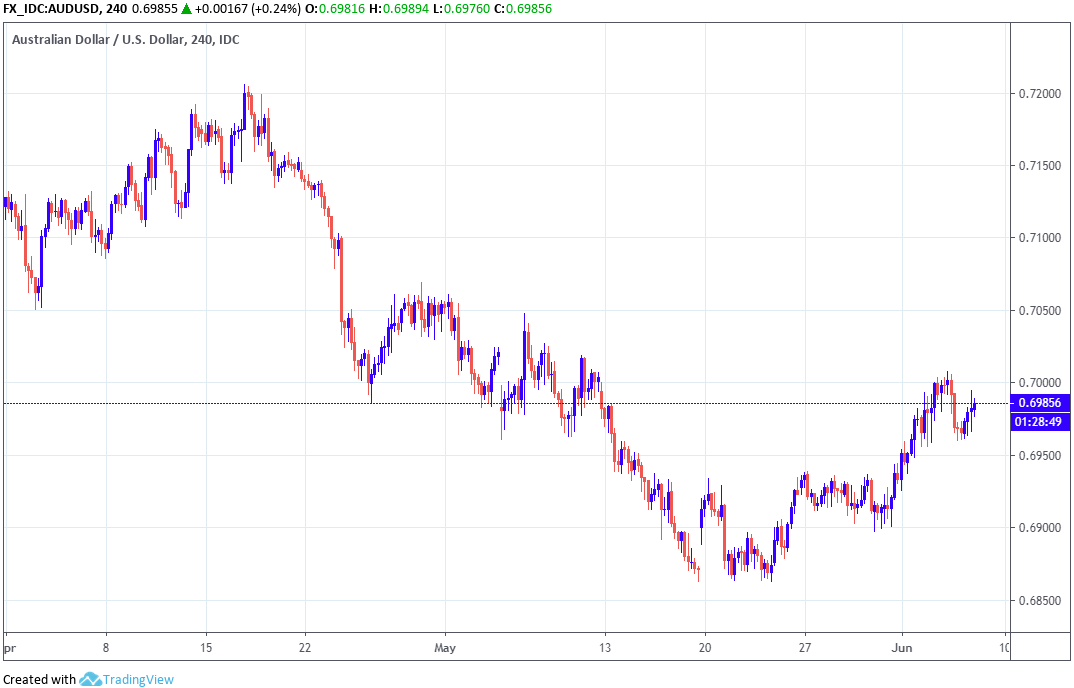
Above: AUD/USD rate shown at 4-hour intervals.
The Aussie economy is being squeezed from both domestic and international sides as global growth slows in the face of an escalating U.S.-China trade war and domestic activity wanes in line with declining consumer spending.
But Australia's Dollar has risen 1% this week and whittled down its 2019 loss also to just 1% even after the Reserve Bank of Australia (RBA) cut its interest rate for the first time in nearly three years, to a new record low of 1.25%.
This performance has borne out even the financial markets betting that another interest rate cut is almost sure to come before the year is out. Resilience is the result of a still-weakening U.S. Dollar and markets already having taken another rate cut to the bank.
The RBA did not to encourage market bets on further reductions to the cash rate from there this week but Westpac says there's a good chance it'll reduce borrowing costs for companies and consumers on two more occasions this year, with the next cut coming in August and another in November.
"AUD’s domestic woes seem set to persist. While business and consumer sentiment surveys might improve post-election, we look for the unemployment rate to remain at 5.2% in May, leaving the RBA pondering how much more it needs to deliver," Callow writes, to clients on Thursday.
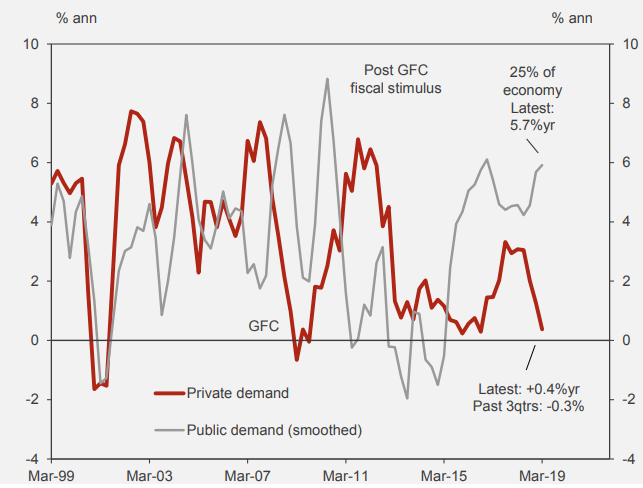
Above: Westpac graph showing divergence between government and consumer spending.
Markets care about the Reserve Bank decisions because changes in interest rates, as well as the outlook for them, can have a significant influence over international capital flows as well as speculative short-term trading activity.
Capital flows tend to move in the direction of the most advantageous or improving returns, with a threat of lower rates normally seeing investors driven out of and deterred away from a currency. Rising rates have the opposite effect.
There are two sides to all Australian Dollar exchange rates and in the case of the AUD/USD and GBP/AUD rates, both opposing currencies have been under pressure themselves in recent weeks.
Brexit as well as fears of broader political instability are front and centre for the UK economy and weighing on Pound Sterling while the U.S. Dollar is being beaten back from its previous highs by a strengthening tide of bets that wager the Federal Reserve will cut its own interest rate before the year is out.
"The slide in US yields helps limit downside on AUD/USD but we still see probes of 0.7000 failing, with a return to the 0.68 handle not far away," Callow warns.
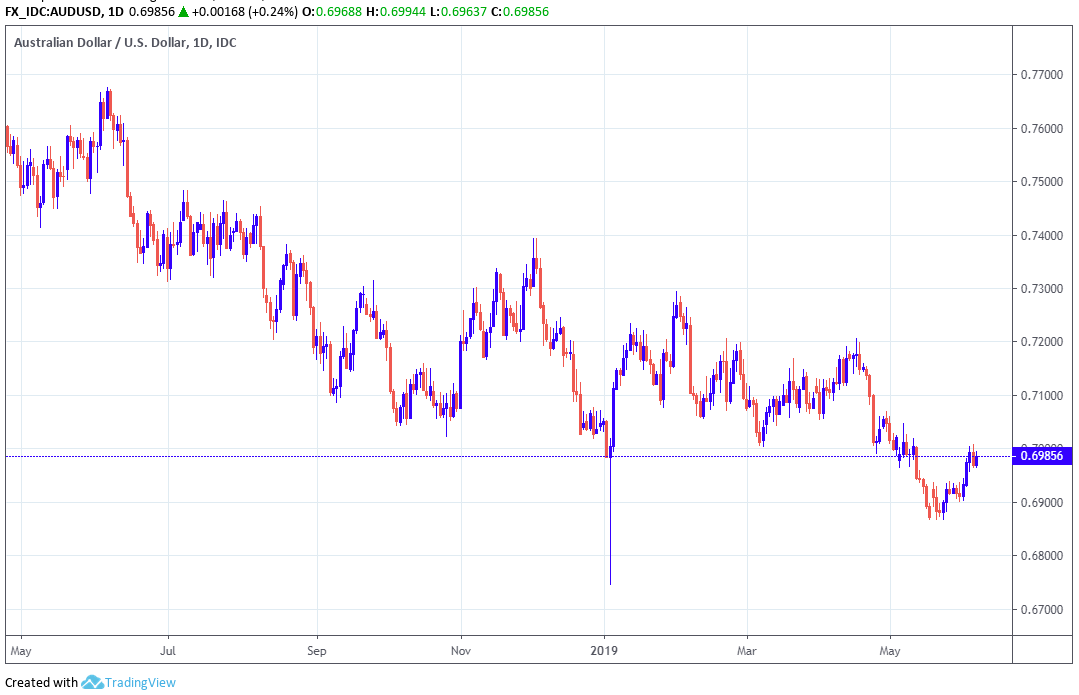
Above: AUD/USD rate shown at daily intervals.
Westpac's forecasts for the AUD/USD rate suggest it will fall all the way to the 0.66 level by the end of December, although the bank is targeting a move down to 0.68 in a trade recommendation sent to institutional clients this week.
It sold AUD/USD at 0.6985 and will walk away from the trade if the market rises to 0.7030 beforehand.
"Opinion polls indicate an increasingly divided population turning against the established parties and so potential for an early general election is slim. The hiatus in all things Brexit due to the Conservative selection process could turn attention to data and surveys," Callow writes, of the UK political environment. "GBP/USD upside should be limited and any data weakness could still trigger a sharp flush to test 1.25."
A now-looming Conservative Party leadership election has effectively put the Brexit process on hold but could have myriad adverse consequences for British currency in the medium term.
Callow says waning support for the governing Conservative and opposition Labour parties means a general election is unlikely but if the next Conservative leader and Prime Minister attempts to engineer a 'no deal' Brexit the opposition and some within the governing party might feel bold enough to act.
Some Conservative MPs have threatened to support an opposition vote of no confidence in the government under such a scenario, although it's far from certain whether they would go that far.
It's also uncertain whether opposition Labour MPs representing Brexit-supporting seats would do that either, once push comes to shove, given such an outcome could lead to the UK's EU exit being cancelled and a possible loss of their own seats.
Westpac forecasts the Pound-to-Australian-Dollar rate will rise to 1.92 by year-end, from 1.82 on Thursday, which is based on the expectation of more losses hitting the AUD/USD rate while the GBP/USD rate ends the year roughly around its Thursday level of 1.27.
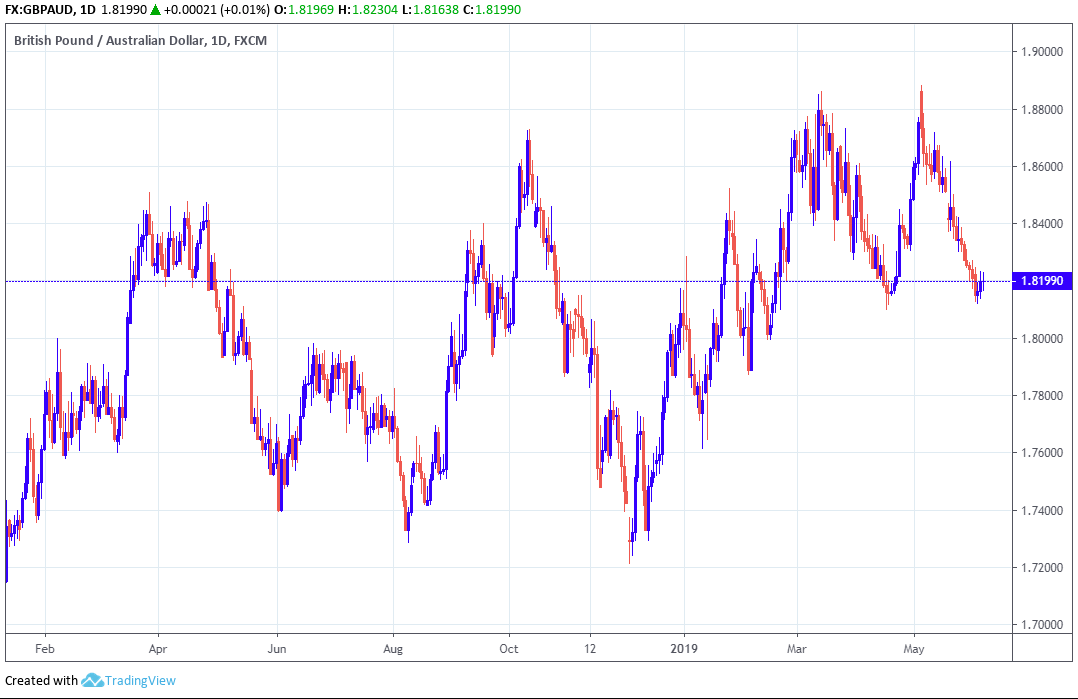
Above: Pound-to-Australian-Dollar rate shown at daily intervals.
Time to move your money? Get 3-5% more currency than your bank would offer by using the services of foreign exchange specialists at RationalFX. A specialist broker can deliver you an exchange rate closer to the real market rate, thereby saving you substantial quantities of currency. Find out more here.
* Advertisement




